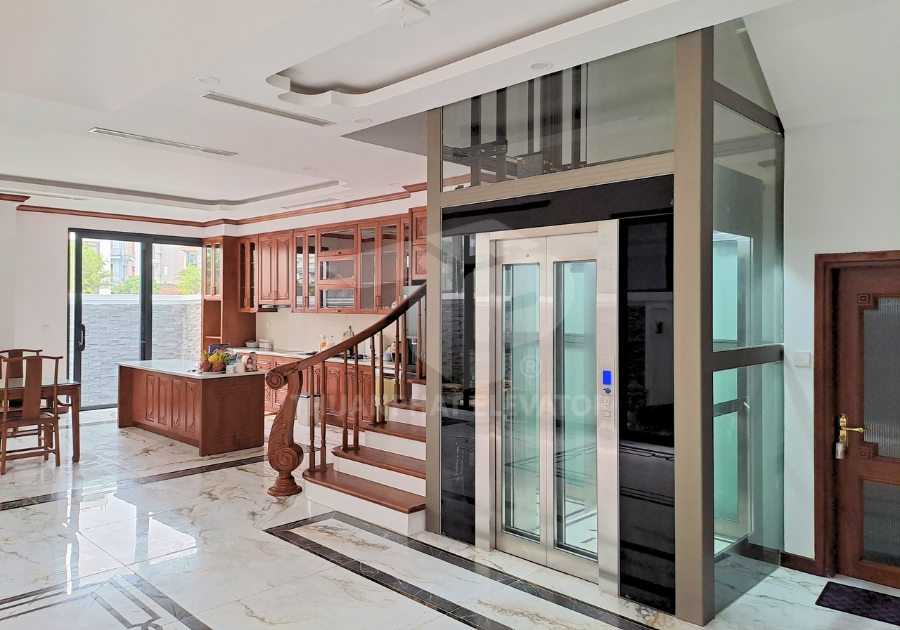Machine Room-Less (MRL) elevators (thang máy gia đình) are rapidly becoming a prominent trend in the construction and architectural sectors. This innovative solution offers numerous benefits to both investors and elevator users. So, what makes MRL elevators so special and attractive? What are the standout advantages that make them a preferred choice?
If your family is considering installing a home elevator without a machine room, what should you keep in mind? What technical information should you be aware of regarding this type of elevator?
1. What is a Machine Room-Less Elevator?
As the name suggests, a Machine Room-Less (MRL) elevator is an elevator system that does not require a separate machine room to house operational components such as the motor and control system. Instead, these components are integrated into the elevator shaft or mounted on top of the elevator car, offering significant benefits in terms of space, cost, and efficiency compared to traditional machine room elevators.

2. Structure of a Machine Room-Less Elevator
An MRL elevator is a complex yet optimized system designed to deliver high performance within a compact space. The structure of an MRL elevator is not vastly different from that of traditional elevators with machine rooms. Below are the main components you should be familiar with:
2.1. Traction Machine:
- Type of Motor: Typically, MRL elevators use a gearless permanent magnet motor, which reduces size and increases efficiency.
- Installation Location: The motor is usually installed on top of the elevator shaft or within the shaft itself, depending on the building's design.
- Function: The traction machine pulls the elevator car up and down by controlling the suspension cables.
2.2. Hoisting Ropes and Sheaves:
- Hoisting Ropes: High-tensile steel cables that connect the elevator car to the counterweight.
- Sheaves: The drive wheel (sheave) changes the direction of the cable's movement and is usually installed alongside the traction machine.
2.3. Elevator Car:
- Design: The elevator car is robustly designed to ensure passenger safety and comfort, often made from stainless steel or aluminum alloys.
- Safety Features: The car is equipped with emergency brakes, overload sensors, and other safety devices to ensure safe operation in all situations.
2.4. Counterweight:
- Function: The counterweight balances the elevator car's weight, reducing the load on the motor and increasing energy efficiency.
- Location: The counterweight is typically positioned behind or beside the elevator car within the shaft.
2.5. Control System:
- Microprocessor Control Unit: The central control system manages all elevator operations, from call processing and speed control to precise stopping at each floor.
- Variable Frequency Drive (VFD): The VFD smoothly adjusts the motor's speed, reducing energy consumption and extending the motor's lifespan.
2.6. Hoistway:
- Structure: The hoistway is the space that houses the elevator car, counterweight, and cable system. It must be securely designed, ensuring safety and compliance with elevator standards.
- Guide Rails: Guide rails ensure that the elevator car and counterweight move vertically, stably, and safely.
3. Advantages of Machine Room-Less Elevators
MRL elevators offer numerous outstanding advantages in terms of space-saving, cost, efficiency, safety, and environmental protection. These benefits explain why MRL elevators are becoming a trend and a priority choice for investors and architects in modern construction projects. If you are looking for an efficient and advanced elevator solution, MRL elevators are the perfect choice.
3.1. Space Saving
- No Need for a Separate Machine Room: MRL elevators eliminate the need for a separate machine room, saving valuable building space. This is especially important for buildings with limited space or where maximizing usable area is crucial.
- Enhanced Aesthetics: The absence of a machine room allows for a more streamlined and modern building design, giving architects greater creative freedom.
3.2. Cost Saving
- Reduced Construction Costs: By not requiring a machine room, MRL elevators reduce construction and installation costs. Investors do not need to allocate funds for designing and building an additional room for the machinery.
- Lower Operating Costs: MRL elevators typically use energy-efficient technologies, such as gearless permanent magnet motors and intelligent control systems, significantly reducing energy consumption during operation.
3.3. High Efficiency
- Speed and Performance: Modern control systems and high-efficiency motors enable MRL elevators to operate smoothly, stably, and quickly.
- Durability: The components of MRL elevators are designed and manufactured to high standards, increasing the system's durability and lifespan. This also helps reduce maintenance frequency and costs.
3.4. Safety and Reliability
- Advanced Safety Systems: MRL elevators are equipped with numerous safety sensors, emergency braking systems, and modern rescue systems. This ensures absolute safety for elevator users in all situations.
- Smart Control: The microprocessor control system continuously monitors and adjusts the elevator's operation accurately, ensuring stable and reliable performance.
Conclusion
In summary, MRL elevators represent a revolutionary solution in the elevator industry, offering significant benefits that make them an attractive option for modern buildings. Their space-saving design, cost efficiency, high performance, and advanced safety features make MRL elevators a wise investment for any construction project.
See more: https://thangmaychinhhang.com/7-uu-diem-cua-thang-may-khong-phong-may/







